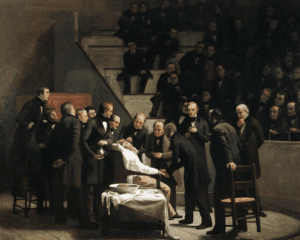Summer A. Niazi
Jack E. Riggs
Morgantown, West Virginia, United States

The words “Gentlemen! This is no humbug” is one of the most famous statements in the history of medicine.1 They were supposedly uttered by the surgeon John Collins Warren on October 16, 1846, following the first public demonstration of an operation using ether inhalation anesthesia. Yet no written record alluding to this statement appeared until 1859, suggesting it may not have been made at all.2
Since Warren died in 1856, he would not have been able to confirm or deny that he spoke those words. He did, however, make the following diary entry on the day of the surgery:
Did an interesting operation at the Hospital this morning while the Patient was under the influence of Dr. Morton’s preparation to prevent pain—the Substance employed was Sulphuric Ether—.3
The first recorded use of the word “humbug” in the context of anesthesia is found in a letter by Horace Wells, a dentist and former partner of Morton’s, to the editor of the Hartford Courant, dated December 7, 1846, and published two days later.
Hartford, Dec. 7, 1846.
Mr. Editor:—You are aware that there has been much said of late respecting a gas, which, when inhaled, so paralizes the system as to render it insensible to pain. . . . As Drs. Charles T. Jackson and W. T. G. Morton, of Boston, claim to be the originators of this invaluable discovery, I will give a short history of its first introduction, that the public may decide to whom belongs the honor . . . Unfortunately for the experiment, the gas bag was by mistake withdrawn much too soon, and he was but partially under its influence when the tooth was extracted. He testified that he experienced some pain . . . several expressed their opinion that it was a humbug affair,4
Horace Wells, who died in 1848, used the word “humbug” in his letter claiming priority for the discovery of anesthesia. He had been unsuccessful in his public demonstration of inhalational anesthesia with nitrous oxide which took place on January 20, 1845. The demonstration had ended in failure when the patient cried out in pain in the middle of the operation, and Wells had been unmercifully jeered by the medical students in the audience.
Why would a false quote attributed to Warren first appear in Trials of a Public Benefactor in 1859? It was likely a deliberate attempt to distort history to persuade Congress to financially reward Morton financially.5 Notes made by Nathan P. Rice, author of Trials, support that claim:
June 6th 1858 – Dr. Morton, a stranger to me, made the proposal to write for him a sketch of his life & history of the discovery of etherization he to Furnish all the materials & be responsible for all the statements personal & otherwise
June 8th 1858 – An agreement was drawn up (vide agreem’t) & the work was commenced – As the mass of materials was found to be too great to be moved the work at his request was done at his house & under his supervision
Oct 18th 1858 – Called in the evening upon Dr. Morton & for the first time was informed of what had been done Found my name upon the title page which I had never intended – a name given which I had never intended, portions which I had not written re-added.6
Moreover, Morton would have been aware of his former partner Wells’ letter, as it had also been published in Trials (pg. 144-5).2 We suggest that Morton, knowing that both Warren and Wells were dead, picked up Wells’ term “humbug” to describe his successful use of inhalation anesthesia as “not a humbug.” It is also unlikely that Warren would use a term as negative as “humbug” to describe this momentous achievement in the annals of medicine.
References
- Haridas RP. “Gentlemen! This is no humbug”, did John Collins Warren, M.D, proclaim these words on October 16, 1846, at Massachusetts General Hospital, Boston? Anesthesiology 2016;124:553-60.
- Rice NP. Trials of a public benefactor, as illustrated in the discovery of etherization. New York: Pudney & Russell, 1859.
- Massachusetts Historical Society, object of the month. Ether Day, 16 October 1846: the Conquest of Pain. October 2016. (https://www.masshist.org/october-2016-2016-10-01)
- Archer WH. Life and letters of Horace Wells, discoverer of anesthesia, chronologically arranged with an appendix. J Amer Coll Dentists 1944;11:81-210.
- Wolfe RJ. Tarnished Idol, William T.G. Morton and the Introduction of Surgical Anesthesia. San Anselmo, California: Norman Publishing, 2001.
- Viets HR. Nathan P. Rice, M.D. and his Trials of a Public Benefactor, New York, 1859. Bull Hist Med 1946;20:232-43.
SUMMER A. NIAZI is an anesthesiology resident at West Virginia University. She is interested in pediatric anesthesiology and the history of medicine.
JACK E. RIGGS is a professor of neurology at West Virginia University.
Highlighted Vignette Volume 13, Issue 3– Summer 2021

Leave a Reply